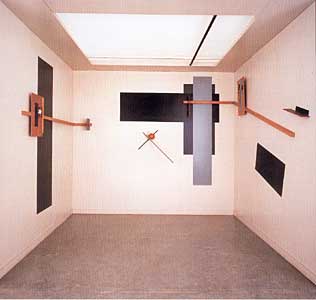20th Century Berlin
The collection of the Berlinische Galerie
The Berlinische Galerie was founded in 1975 to fill one specific gap and respond to one single aim: to bring together works by artists who were from Berlin or had lived in the German capital at some time between the turn of the century and the present day. The museums in Berlin for subjects ranging from archaeology to classical and international collections were among the most important in the world, but what was lacking was the rich, complex and sometimes painful history of art in that unique metropolis. Since then, the Berlinische Galerie&’s collection has demonstrated Berlin’s position as one of the intellectual capitals of Europe, especially in the twenties, and as a direct participant in the history of art in the first third of the twentieth century, involved in movements ranging from Expressionism to Dadaism and from New Objectivity to Constructivism, which accompanied the intense creativity that enlivened the worlds of cinema, theatre, literature, photography and architecture. In the present exhibition, German Expressionism is represented by the work of artists such as Ernst Ludwig Kirchner, Erich Heckel, Karl Schmidt-Rottluff and Ludwig Meidner. The November Group, so called because of the revolutionary demonstrations along Russian lines that broke out in Germany at the end of the First World War, attracted numerous artists from various disciplines and aesthetics, such as Arthur Segal, Otto Freundlich, Otto Mueller and Issaï Kulvianski. A large Dada section recalling the great Erste Internationale Dada-Messe in Berlin in 1920 contains works and archives corresponding to the main actors in that movement, which managed to investigate every possibility of collage, invert the approach to photomontage and introduce innovation in the area of typography. The exhibition recreates the Dada atmosphere with works by Raoul Hausmann, Johannes Baader, Hannah Höch, John Heartfield, George Grosz and Rudolf Schlichter, who increased their impact by many different means, including pamphlets, magazines, posters, exhibitions, manifestos and postcards. New Objectivity took up a position that set it apart from Expressionism and revealed a vigorous return to a realism that spanned a broad spectrum ranging from cold, distant, unusual, timeless reflection to grotesque caricature and accusation. The chief representatives of this section are George Grosz and Otto Dix, who had moved on from the world of Dada, together with Rudolf Schlichter, Christian Schad, Alexander Kanoldt, Gustav Wunderwald and Karl Hofer. In the early twenties, attracted by the intellectual effervescence reigning in Berlin, a large number of artists from Hungary, Poland, Romania and especially Russia came to Berlin for varying periods and spread the word about avant-garde experiments in their native countries. They had a decisive influence on art in Germany, an influence that subsequently extended to the rest of western Europe, particularly Paris. Three personalities are featured in this section, Ivan Puni, Naum Gabo and El Lissitzky, the last of whom organised the first exhibition of Russian art in Berlin in 1922 and created his Prounen-Raum (Proun-Space) for the Grosse Berliner Kunstausstellung which was presented the following year. The twenties saw the striking success of photojournalism, which focused on topical issues. Magazines and newspapers increased their demand for pictures rather than words. Between 1928 and 1933 Erich Salomon became the photographer who specialised in international conferences and sessions in the Reichstag. Erwin Blumenfeld, an active member of the Dada group in Berlin and associated with Surrealism, became known world-wide for his portraits and fashion photos, which in 1938 began to appear in Vogue, Harper’s Bazaar, Cosmopolitan and Look. Various women established themselves as famous photographers during the twenties, including Marta Astfalk-Vietz, Marianne Breslauer and Steffi Brandl, and work by them is presented in the exhibition. This section is complemented by photographs by Raoul Hausmann, Umbo, Hans Casparius, Sasha Stone, László Moholy-Nagy, El Lissitzky and Rodchenko. Other artists of German nationality or closely linked to the city of Berlin are also represented, including Hans Uhlmann, George Rickey, Wolf Vostell, Baselitz, Schönebeck, Hödicke, Marwan, Koberling and Edward Kienholz, whose famous piece The Art Show can be seen in the exhibition.



